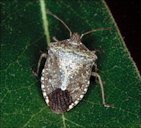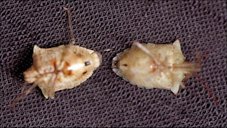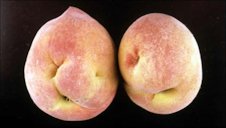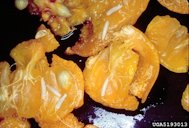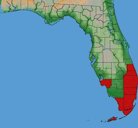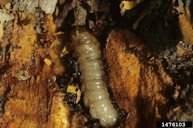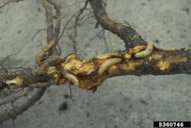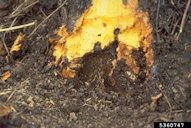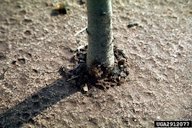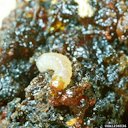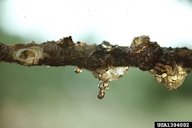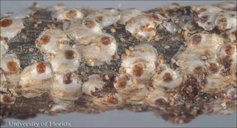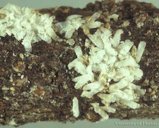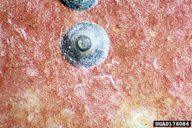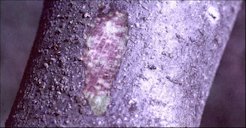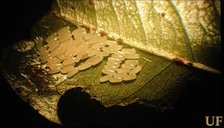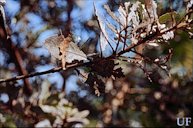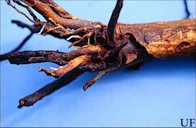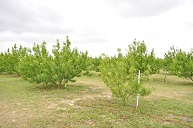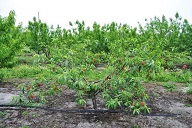| Peach Pests | ||||||||||||||||||||||||||||||||||||||||||||||||||||||
|---|---|---|---|---|---|---|---|---|---|---|---|---|---|---|---|---|---|---|---|---|---|---|---|---|---|---|---|---|---|---|---|---|---|---|---|---|---|---|---|---|---|---|---|---|---|---|---|---|---|---|---|---|---|---|
| Back
to Peach Page 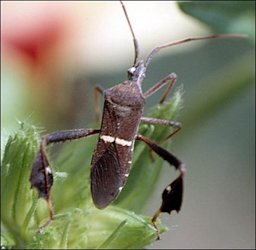 Fig. 1  Leaffooted bug Leptoglossus phyllopus (L.) 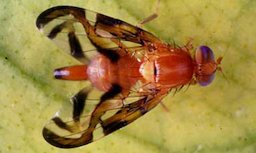 Fig. 5  Adult female Caribbean fruit fly, Anastrepha suspensa (Loew) 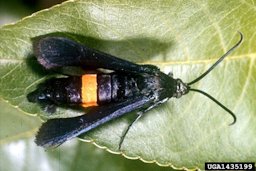 Fig. 8  Female peach tree borer, Synanthedon exitiosa (Say) 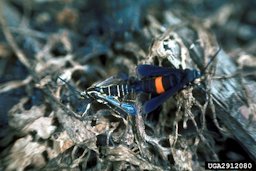 Fig. 8b  Peachtree borer (Synanthedon exitiosa) female on right, male on left 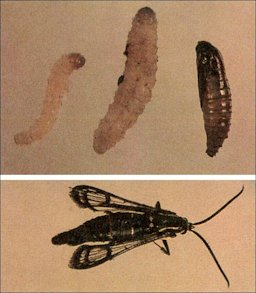 Fig. 14  Larvae, pupa and adult of the lesser peachtree borer 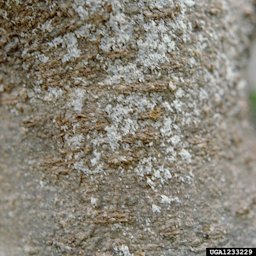 Fig. 19  White peach scale infestation on peach tree 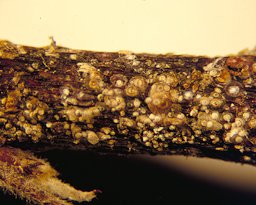 Fig. 23  Peach twig infested with San Jose Scale 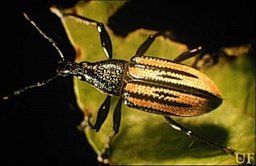 Fig. 27  Adult Diaprepes abbreviatus (L.) 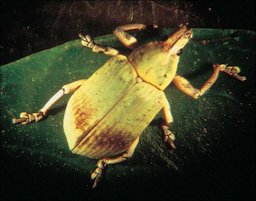 Fig. 31 
Southern citrus root weevil, Pachnaeus litus 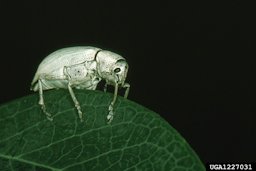 Fig.
32 Fig.
32 
Northern citrus root weevil, Pachnaeus opalus 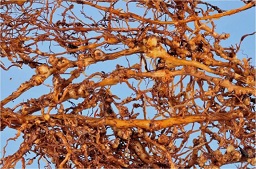 Fig. 33  Root galls caused by root-knot nematode, Meloidogyne floridensis
|
Pests
in Florida peaches and nectarines occur throughout the season and
attack both the trees and fruit. The primary pests of fruit are plum
curculio (North Central and North Florida), stink bugs, and Caribbean
fruit fly (Central and South Florida). Occasional fruit pests include
scarab beetles, thrips, and nitidulid sap beetles. The major pests of
the tree trunk and roots are the peach tree borer, which attacks the
base and lower scaffold limbs of the tree; the lesser peach tree borer,
which attacks scaffold branches; white peach scale; and San Jose scale.
Since systematic research on pest damage to stone fruit has not been
widely conducted in South Florida, damage caused by other pests
specific to that area may increase as plantings expand, requiring
additional management. 1 Stink Bugs (Fig. 1) Euschistus spp. Euschistus spp. are the most important stink bugs and Leptoglossus spp. are the most important leaffooted bugs infesting peach and nectarine. Species from both genera emerge from overwintering sites before or during bloom and fruit set. Early emerging adults often feed on winter-annual weeds. The bugs begin fruit feeding around the time that the fruit enters the shuck split stage. Stink and leaffooted bugs are piercing-sucking feeders. They use their saliva to penetrate their food material, dissolve the contents and then suck up the digesting mixture. Feeding damage in peach and nectarine destroys part of the developing fruit. As a result of this loss, the damaged portion of the fruit does not grow. As the healthy tissue continues to grow around the damaged area, this uneven growth forms the typical fruit injury known as catfacing. Fruits with catfacing damage are not marketable and usually fall from the tree prematurely if damaged in early season. 3 Stink bugs are difficult to control with insecticides. There are very few tools available to homeowners and organic growers. Because stink bugs and leaffooted bugs have many hosts and are very mobile, they can become a problem at any time during the season. They can be removed by hand or with a butterfly net from small plantings in gardens. 3
Fig. 2. An adult brown stink bug, Euschistus servus (Say). Fig. 3. Adult female (left) and male (right) Further Reading Stink Bugs and Leaffooted Bugs are Important Fruit, Nut, Seed and Vegetable Pests, University of Florida pdf The Brown Marmorated Stink Bug, Halyomorpha halys (Stål), University of Florida pdf Brown Stink Bug, Euschistus servus (Say), University of Florida pdf Leaffooted Bug, Leptoglossus phyllopus (Linnaeus), University of Florida pdf Managing Stink Bugs on Peaches, Vegetable and Specialty Crop News Caribbean Fruit Fly (Fig. 5) Anastrepha suspensa (Loew) (Insecta: Diptera: Tephritidae) Within the first three months following the discovery of A. suspensa in Florida in 1965, more than 14,000 adults were trapped in Dade County and identified by state entomologists. It has now developed into a major fruit fly problem for citrus and several other crops in Florida. 2 Use of Diachasmimorpha longicaudata, a solitary, endoparasitic braconid wasp, is planned as part of a two-pronged attack on the Caribbean fruit fly involving the release of parasites and sterile Caribbean fruit flies.
Fig. 6. Larvae Fig. 7. Distribution of the Caribbean fruit fly in Florida Further Reading Caribbean Fruit Fly, University of Florida pdf A Parasitoid Wasp, Diachasmimorpha longicaudata, University of Florida pdf Managing Caribbean Fruit Fly on Peaches, Vegetable and Specialty Crop News Peach Tree Borer (Fig. 8) Synanthedon exitiosa (Say) The peachtree borer, Synanthedon exitiosa (Say), is a very serious agronomic pest. The peachtree borer and the lesser peachtree borer, Synanthedon pictipes, account for more damage to peach trees than all other insect pest combined. The peachtree borer can damage the tree in two ways: girdling and inducing plant pathogens to invade the weakened tree. 5
Fig. 9. Peach tree borer larva(e) Fig. 9b. Late stage larva showing crochets of prolegs Fig. 10. Larvae of the peach tree (crown) borer, S. exitiosa Fig. 11. Damage to the base of a peach tree Fig. 12. Damage to 1 year old tree in Thomason, Georgia Fig. 13. Damage at the base of a young peach tree Lesser Peachtree Borer (Fig. 14) Synanthedon pictipes (Grote & Robinson) LPTB females lay their eggs on the trunk above ground, but infestations are higher on the scaffold limbs chiefly in areas previously injured by machinery, disease, or weather, and in crotches or under loose bark. LPTB larvae are similar in appearance, feeding habits, and damage to PTB larvae, although LPTB are somewhat smaller and do not feed below ground. 6 Recent research has shown that entomophagous nematodes are very efficacious against both species of peachtree borers. The peachtree borer is especially susceptible as it feeds in the moist areas around the root crown. The lesser peachtree borer is harder to control because the nematodes need moisture to survive and the scaffold limbs are not moist enough. The search for methods to circumvent this problem to achieve borer biological control is ongoing. 6
Fig. 15. Lesser peachtree borer (Synanthedon pictipes) larva(e) Fig. 16. Gummosis caused by the lesser peachtree borer Fig. 17,18. Damage by the lesser peachtree borer Further Reading Peachtree Borer, Synanthedon exitiosa (Say), University of Florida pdf Peach Tree Borers in the Home and Commercial Peach Orchard, University of Florida pdf Pointers for Peachtree Borer Management, Vegetable and Specialty Crop News White Peach Scale (Fig. 19) Pseudaulacaspis pentagona (Targioni) This insect is an important economic pest of peach trees as well as woody ornamentals in the southeastern United States. In the early part of this century, white peach scale destroyed numerous peach orchards in Florida and completely decimated a grove of 10,000 peach trees in south Georgia. 7 Predators. In Florida, several predators feed on white peach scale. Primarily, these species are ladybird beetles (Coleoptera: Coccindellidae), and common lacewings (Neuroptera: Chrysopidae). Some gall midges, (Diptera: Cecidomyiidae) also attack white peach scale. 7
Fig. 20. Adults and immatures of the white peach scale, P. pentagona (Targioni) Fig. 21. Adult female white peach scales Fig. 22. Adult male white peach scale Further Reading White Peach Scale, Pseudaulacaspis pentagona (Targioni), University of Florida pdf Managing Scales in Peach Orchards, Vegetable and Specialty Crop News San Jose Scale (Fig. 23) Quadraspidiotus perniciosus San Jose scale is a piercing sucking insect that can be devastating to trees if populations are allowed to establish. After hatching, the female probes through the bark and sucks plant juices for food. About one week after inserting her mouthpart, she will develop a waxy coating. Once this is developed, she cannot be killed by insecticidal poisons. The hatch does not occur all at once, which further limits the effectiveness of poisons. San Jose scale appears as grayish, raised waxy spots on the tree bark. Unlike the larger white peach scale that can be easily spotted in the late summer because of its snowy white male populations, San Jose scale is not easy to see. However, populations can be confirmed by slicing a small sliver of bark off at the cambial layer and observing purplish dots on the limb where the female has been feeding (Fig. 26). 8
Fig. 24. San Jose scale (Diaspidiotus perniciosus) (Comstock). Close up of adult female Q. perniciosus, showing circular grey scale Fig. 25. San Jose scale (D. perniciosus) (Comstock). Adult(s) Fig. 26. San Jose scale on the bark with exposed red coloration where the female has probed and is feeding in the cambium Further Reading Peach Pruning Improves San Jose Scale Control, Vegetable and Specialty Crop News Root Weevils Pachnaeus litus, P. opalus and Diaprepes abbreviates As increasing numbers of orchards are planted in former citrus groves, root weevils, such as blue green weevils Pachnaeus litus (Fig. 31) and Pachnaeus opalus (Fig. 32) and diaprepes (Diaprepes abbreviates) root weevil (Fig. 27), have been found on peach root systems. These insects can be responsible for tree decline and death in peaches as well as in citrus crops. The most damaging stage of both types of root weevils is the larval stage, at which time they can weave their way through the root system, creating extensive "galleries" or mazes of damage. Pachnaeus opalus is found in the northern areas of Florida and Pachnaeus litus is found in southern Florida. 6
Fig. 28. Egg mass of Diaprepes abbreviatus (L.), on citrus leaf Fig. 29. Damage, notching on leaves Fig. 30. Damage to citrus tree roots Further Reading Diaprepes Root Weevil, Diaprepes abbreviatus, University of Florida pdf Field Diagnosis of Citrus Root Weevil Damage, University of Florida pdf Nematodes One of the production issues that peach growers in Florida must contend with is plant-parasitic nematodes. Problem nematodes that have been identified on peach include root-knot nematodes (Meloidogyne spp.), lesion nematodes (Pratylenchus spp.), and ring nematodes (Mesocriconema xenoplax). To date, the most important of these three genera of nematodes to Florida peach growers is root-knot nematodes. 9 These nematodes thrive in warm, sandy soils, making it necessary to graft peach scions onto nematode-resistant rootstocks. Root infection by these nematodes results in the decline of peach tree health and reductions in fruit quantity and quality. 9
Fig. 34. Damage symptoms caused by root-knot nematodes on peach. Trees on the left are healthy, but the one on the right shows yellowing, stunting, and reduced vigor. Fig. 35. Reduction in foliage is resulting in the production of poor quality fruit. Further Reading Peach Root-knot Nematode, University of Florida pdf Further Reading Insect Management in Peaches, University of Florida ext link Southeastern Peach, Nectarine, and Plum Pest Management and Culture Guide, Georgia University pdf |
|||||||||||||||||||||||||||||||||||||||||||||||||||||
| Bibliography 1 Olmstead, Mercy, et al. "Florida Peach and Nectarine Varieties." Horticultural Sciences Dept., (originally published in 1995 as "Peaches and Nectarines for Central and North Florida), UF/IFAS Extension, Circ. 1159, Original pub. Nov. 1995, Rev. May 2013, June 2016, and Oct. 2018, AskIFAS, edis.ifas.ufl.edu/mg374. Accessed 15 Sept. 2014, 16 Feb. 2017, 2 Apr. 2019. 2 Weems, H. V., et al. "Caribbean Fruit Fly, Anastrepha suspensa (Loew) (Insecta: Diptera: Tephritidae)." Entomology and Nematology Dept., (originally published as DPI Entomology Circulars 38 and 260), UF/IFAS Extension, EENY-196, Original pub. Mar. 2001, Revised Mar. 2012 and June 2021, AskIFAS, edis.ifas.ufl.edu. Accessed 29 Jan. 2014, 23 Apr. 2017, 14 Feb. 2023. 3 Mizell, Russell F. III. "Stink Bugs and Leaffooted Bugs Are Important Fruit, Nut, Seed and Vegetable Pests." Dept. of Entomology and Nematology, UF/IFAS Extension, ENY-718, Original pub. Apr. 2005, Rev. July 2018, AskIFAS, edis.ifas.ufl.edu/in534. Accessed 29 Jan. 2014, 10 Oct. 2018. 4 Olmstead, M., et al. "Florida Subtropical Peaches: Production Practices." Horticultural Sciences Dept., UF/IFAS Extension, HS1109, Pub. July 2007, Revised Aug. 2013, Archived, AskIFAS, edis.ifas.ufl.edu. Accessed 5 Sept. 2014, 7 Feb. 2017. 5 Strickland, Stacy, J. "Peachtree Borer, Synanthedon exitiosa (Say) (Insecta: Lepidoptera: Sesiide)." Dept. of Entomology and Nematology, UF/IFAS Extension, EENY260, Original pub. Jan. 2002, Revised June 2006, Nov. 2014, and June 2021, AskIFAS, edis.ifas.ufl.edu/in524. Accessed 15 Sept. 2014, 10 Oct. 2018, 14 Feb. 2023. 6 Mizell, Russell F. III. "Peach Tree Borers in the Home and Commercial Peach Orchard." Entomology and Nematology Dept., UF/IFAS Extension, ENY-691, Original pub. Dec. 1985, Revised july 2018, AskIFAS, edis.ifas.ufl.edu/in489. Accessed 16 Sept. 2014, 7 Feb. 2017, 2 Oct. 2020. 7 Branscome, Deanna. "White Peach Scale, Pseudaulacaspis pentagona (Targioni) (Insecta: Hemiptera: Diaspididae)." Entomology and Nematology Dept., UF/IFAS Extension, EENY-076, Published Aug. 2003. Rev. Aug. 2012, and June 2022, AskIFAS, edis.ifas.ufl.edu/in233. Accessed 16 Sept. 2014, 7 Feb. 2017, 12 Apr. 2019, 14 Feb. 2023.. 8 Sarkhosh, A., et al. "Growing Plums in Florida." Horticultural Sciences Dept., UF/IFAS Extension, HS895, Original pub. Mar. 2005, Revised Apr. 2012, Jan. 2016., and Sept. 2018, AskIFAS, edis.ifas.ufl.edu/hs250. Accessed 19 Sept. 2014, 7 Feb. 2017, 2 Oct. 2020. 9 Maquilan, Mary Ann D., et al. "Peach Root-knot Nematode." Horticultural Sciences Dept., UF/IFAS Extension, HS1320, Original pub. July 2018, AskIFAS, edis.ifas.ufl.edu/hs1320. Accessed 19 Sept. 2018. Photographs Fig. 1 "The leaftooted bug Leptoglossus phyllopus (L.)." UF/IFAS, AskIFAS, edis.ifas.ufl.edu. Accessed 15 Sept. 2014. Fig. 2 Tedders, W. L. "An adult brown stink bug, Euschistus servus (Say)." UF/IFAS, AskIFAS, edis.ifas.ufl.edu. Accessed 15 Sept. 2014. Fig. 3 "Euschistus servus (Say) adult female (left) and male (right)." UF/IFAS, AskIFAS, edis.ifas.ufl.edu. Accessed 15 Sept. 2014. Fig. 4 "Catfacing damage to Peach." UF/IFAS, edis.ifas.ufl.edu. Accessed 15 Sept. 2014. Fig. 5 "Adult female Caribbean fruit fly, Anastrepha suspensa." Division of Plant Industry, AskIFAS, edis.ifas.ufl.edu. Accessed 15 Sept. 2014. Fig. 6 Caribbean fruit fly, Anastrepha suspensa larvae." Florida Division of Plant Industry Archive, Florida Department of Agriculture and Consumer Services, 2010, Bugwood.org, www.bugwood.org. Accessed 15 Sept. 2014. Fig. 7 Steck, G. J., and B. D. Sutton. "Distribution of the Caribbean fruit fly, Anastrepha suspensa (Loew), in Florida." Florida Department of Agriculture and Consumer Services, www.freshfromflorida.com. Accessed 16 Sept. 2014. Fig. 8 Solomon, James. "Female peach tree borer, Synanthedon exitiosa (Say)." Bugwood.org, 2002, (CC BY 3.0 US), www.bugwood.org. Accessed 16 Sept. 2014. Fig. 8b Ellis, H. C. "Peachtree borer (Synanthedon exitiosa) female on right, male on left." University of Georgia, 1999, Updated 2002, Bugwood.org, (CC BY 3.0 US), www.bugwood.org. Accessed 6 Feb. 2017. Fig. 9 Cranshaw, Whitney. "Peachtree borer larva(e), Synanthedon exitiosa (Say)." Colorado State University, 2010, Bugwood.org, (CC BY 3.0 US), www.bugwood.org. Accessed 16 Sept. 2014. Fig. 9b Cranshaw, Whitney. "Peachtree borer (Synanthedon exitiosa). Late stage larva showing crochets of prolegs." Colorado State University, 2010, Updated 2011, Bugwood.org, (CC BY 3.0 US), www.bugwood.org. Accessed 6 Feb. 2017. Fig. 10 Nelson, Eugene E. "Larvae of the peach tree (crown) borer, Synanthedon exitiosa." Bugwood.org, 2008, (CC BY 3.0 US), www.bugwood.org. Accessed 16 Sept. 2014. Fig. 11 Nelson, Eugene E. "Damage to the base of a peach tree, caused by larvae of the peach tree (crown) borer, Synanthedon exitiosa." Bugwood.org, 2008, (CC BY 3.0 US), www.bugwood.org. Accessed 16 Sept. 2014. Fig. 12 Ellis, H. C. "Peachtree borer (Synanthedon exitiosa). Damage to 1 year old tree in Thomason, Georgia." University of Georgia, 1999, Updated 2002, Bugwood.org, (CC BY 3.0 US), www.bugwood.org. Accessed 16 Sept. 2014. Fig. 13 Solomon, James. "Peachtree borer (Synanthedon exitiosa). Damage at the base of a young peach tree." USDA Forest Service, 1999, Updated 2001, Bugwood.org, (CC BY 3.0 US), www.bugwood.org. Accessed 16 Sept. 2014. Fig. 14 "Larvae, pupa and adult of the lesser peachtree borer." UF/IFAS, AskIFAS, edis.ifas.ufl.edu. Accessed 16 Sept. 2014. Fig. 15 "Lesser Peachtree Borer Larva(e)." Clemson University, USDA Cooperative Extension Slide Series, 2003, Updated 2011, Bugwood.org, (CC BY 3.0 US), www.bugwood.org. Accessed 16 Sept. 2014. Fig. 16,17,18 Younce, Carroll E. "Lesser Peachtree Borer Damage." USDA Agricultural Research Service, 2003, Updated 2011, Bugwood.org, (CC BY 3.0 US), www.bugwood.org. Accessed 16 Sept. 2014. Fig. 19 "White Peach Scale Infestation on Peach Tree." Clemson University, USDA Cooperative Extension Slide Series, 2003, Updated 2011, Bugwood.org, (CC BY 3.0 US), www.bugwood.org. Updated 2011. Accessed 16 Sept. 2014. Fig. 20 Buss, Lyle J. "Adults and immatures of the white peach scale, Pseudaulacaspis pentagona (Targioni)." UF/IFAS, AskIFAS, edis.ifas.ufl.edu. Accessed 16 Sept. 2014. Fig. 21 Buss, Lyle J. "Female of the white peach scale, Pseudaulacaspis pentagona (Targioni)." UF/IFAS, AskIFAS, edis.ifas.ufl.edu. Accessed 16 Sept. 2014. Fig. 22 Buss, Lyle J. "Male of the white peach scale, Pseudaulacaspis pentagona (Targioni)." UF/IFAS, AskIFAS, edis.ifas.ufl.edu. Accessed 16 Sept. 2014. Fig. 23 "Peach twig infested with San Jose Scale." Utha State University Cooperative Extension, utahpests.usu.edu. Accessed 16 Sept. 2014. Fig. 24 "Close up of adult female Quadraspidiotus perniciosus, showing circular grey scale." Biologische Bundesanstalt für Land- und Forstwirtschaft Archive, 2004, Updated 2016, Bugwood.org, (CC BY 3.0 US), www.bugwood.org. Accessed 16 Sept. 2014. Fig. 25 "Adult of San Jose scale in the field." United States National Collection of Scale Insects Photographs Archive, USDA Agricultural Research Service, 2006, Updated 2011, Bugwood.org, (CC BY 3.0 US), www.bugwood.org. Accessed 17 Sept. 2014. Fig. 26 "San Jose scale on the bark with exposed red coloration where the female has probed and is feeding in the cambium." UF/IFAS, AskIFAS, edis.ifas.ufl.edu. Accessed 17 Sept. 2014. Fig. 27,29,30 Pena, Jorge. "Diaprepes abbreviatus (L.)." UF/IFAS, AskIFAS, edis.ifas.ufl.edu. Accessed 17 Sept. 2014. Fig. 28 Butler, Jerry F. "Egg mass of Diaprepes abbreviatus (L.), on citrus leaf." UF/IFAS, AskIFAS, edis.ifas.ufl.edu. Accessed 17 Sept. 2014. Fig. 31 "Southern Citrus Root Weevil, Pachnaeus litus." UF/IFAS, AskIFAS, edis.ifas.ufl.edu. Accessed 17 Sept. 2014. Fig. 32 Payne, Jerry A. "Northern Citrus Root Weevil, Pachnaeus opalus (Oliver, 1807)." USDA Agricultural Research Service, 2003, Bugwood.org, (CC BY 3.0 US), www.bugwood.org. Accessed 17 Sept. 2014. Fig. 33 Brito, Janet. "Root galls caused by root-knot nematode, Meloidogyne floridensis." UF/IFAS, AskIFAS, edis.ifas.ufl.edu/hs1320. Accessed 19 Sept. 2018. Fig. 34 Maquilan, Mary Ann D. "Damage symptoms caused by root-knot nematodes on peach. Trees on the left are healthy, but the one on the right shows yellowing, stunting, and reduced vigor." UF/IFAS, edis.ifas.ufl.edu/hs1320. Accessed 19 Sept. 2018. Fig. 35 Maquilan, Mary Ann D. "Reduction in foliage is resulting in the production of poor quality fruit." UF/IFAS, AskIFAS, edis.ifas.ufl.edu/hs1320. Accessed 19 Sept. 2018. Published 15 Sept. 2014 LR. Last update 14 Feb. 2023 LR |
||||||||||||||||||||||||||||||||||||||||||||||||||||||
